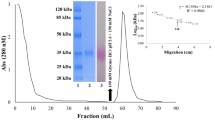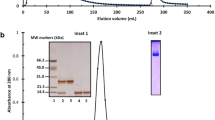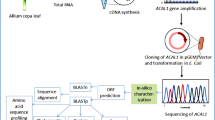Abstract
Key message
Trimeric Galanthus nivalis agglutinin-related lectin of Orchidaceae with two conformational forms was first studied in Dendrobium pendulum . It was highly expressed by stress factors.
Abstract
Using mannan–agarose column chromatography, a mannose-binding protein was purified from Dendrobium pendulum Roxb. pseudobulb. After heating in the presence of sodium dodecyl sulfate (SDS) with or without 2-mercaptoethanol, the protein showed one band with molecular mass of 14.0 kDa on SDS-polyacrylamide gel electrophoresis (PAGE). Without heating, three bands were found at positions of 14.0, 39.4, and 41.5 kDa, but a higher amount of 39.4 and 41.5 kDa protein bands were seen in the presence of 2-mercaptoethanol. Liquid chromatography–tandem mass spectrometry and database search indicated that the 14.0 kDa protein band contained three peptide fragments identical to parts of a lectin precursor from Dendrobiu m findleyanum Parish & Rchb.f. Native-PAGE and Ferguson plot showed that the purified protein had two native forms with molecular masses of 44.2 and 45.3 kDa, indicating three 14.0 kDa polypeptide subunits. The purified protein exhibited the agglutination activity with trypsinized chicken erythrocytes. It was then recognized as a Galanthus nivalis agglutinin-related lectin and named D. pendulum agglutinin (DPA). Using reverse transcription-polymerase chain reaction and DNA sequencing, the deduced amino acid sequence of DPA precursor showed the highest homology (96.4 %) with a lectin precursor of D. findleyanum and contained three mannose-binding sites. Greater amounts of DPA were found when the pseudobulbs were treated with stress factors including ultraviolet light, abscisic acid, hydrogen peroxide, and acetylene gas.










Similar content being viewed by others
References
Asif M (2012) Physico-chemical properties and toxic effect of fruit-ripening agent calcium carbide. Ann Trop Med Public Health 5:150–156
Babosha AV (2006) Changes in the content of wheat germ agglutinin in hydrogen peroxide-treated plants. Appl Biochem Micro 42:220–223
Balzarini J (2006) Inhibition of HIV entry by carbohydrate-binding proteins. Antiviral Res 71:237–247
Balzarini J, Neyts J, Schols D, Hosoya M, Van Damme E, Pseumans W, De Clercq E (1992) The mannose-specific plant lectins from Cymbidium hybrid and Epipactis helleborine and the (N-acetylglucosamine) n -specific plant lectin from Urtica dioica are potent and selective inhibitors of human immunodeficiency virus and cytomegalovirus replication in vitro. Antiviral Res 18:191–207
Balzarini J, Hatse S, Vermeire K, Princen K, Aquaro S, Perno CF, De Clercq E, Egberink H, Vander Mooter G, Peumans W, Van Damme E, Schols D (2004) Mannose-specific plant lectins from the Amaryllidaceae family qualify as efficient microbicides for prevention of human immunodeficiency virus infection. Antimicrob Agents Chemother 48:3858–3870
Barre A, Bourne Y, Van Damme EJM, Peumans WJ, Rouge P (2001) Mannose-binding plant lectins: different structural scaffolds for a common sugar-recognition process. Biochimie 83:645–651
Bekesiova I, Nap JP, Mlynarova L (1999) Isolation of high quality DNA and RNA from leaves of the carnivorous plant Drosera rotundifolia. Plant Mol Biol Rep 17:269–277
Chen Y, Peumans WJ, Hause B, Bras J, Kumar M, Proost P, Barre A, Rougé P, Van Damme EJM (2002) Jasmonate methyl ester induces the synthesis of a cytoplasmic/nuclear chitooligosaccharide-binding lectin in tobacco leaves. FASEB J 16:905–907
Chen Z, Sun X, Tang K (2005a) Cloning and expression of a novel cDNA encoding a mannose-binding lectin from Dendrobium officinale. Toxicon 45:535–540
Chen Z, Sun X, Tang K (2005b) Molecular cloning and characterization of a mannose-binding lectin gene from Dendrobium officinale. J Plant Biochem Biotechnol 14:33–36
Gupta S, Das S (2012) Exploring the defensive roles and regulations of GNA domain containing monocot mannose specific lectins. Sci Cult 78:233–241
Kong Y, Kim WB, Kang SY, Cho SY (1991) Molecular weight of major component proteins in crude saline extract of adult Paragonimus westermani. Korean J Parasitol 29:113–120
Kucera B, Leubner-Metzger G, Wellmann E (2003) Distinct ultraviolet-signaling pathways in bean leaves. DNA damage is associated with β-1,3-glucanase gene induction, but not with flavonoid formation. Plant Physiol 133:1445–1452
Lannoo N, Van Damme EJM (2010) Nucleocytoplasmic plant lectins. Biochim Biophys Acta 1800:190–201
Lannoo N, Vandenborre G, Miersch O, Smagghe G, Wasternack C, Peumans WJ, Van Damme EJM (2007) The Jasmonate-induced expression of the Nicotiana tabacum leaf lectin. Plant Cell Physiol 48:1207–1218
Lyou SH, Park HJ, Jung C, Sohn HB, Lee G, Kim CH, Kim M, Choi YD, Cheong JJ (2009) The Arabidopsis AtLEC gene encoding a lectin-like protein is up-regulated by multiple stimuli including developmental signal, wounding, jasmonate, ethylene, and chitin elicitor. Mol Cells 27:75–81
Parret AHA, Schoofs G, Proost P, De Mot R (2003) Plant lectin-like bacteriocin from a rhizosphere-colonizing Pseudomonas isolate. J Bacteriol 185:897–908
Parret AHA, Temmerman K, De Mot R (2005) Novel lectin-like bacteriocins of biocontrol strain Pseudomonas fluorescens Pf-5. Appl Environ Microbiol 71:5197–5207
Peumans WJ, Van Damme EJM (1995) Lectins as plant defense proteins. Plant Physiol 109:347–352
Peumans WJ, Barre A, Bras J, Rougé P, Proost P, Van Damme EJM (2002) The liverwort contains a lectin that is structurally and evolutionary related to the monocot mannose-binding lectins. Plant Physiol 129:1054–1065
Sattayasai N, Sudmoon R, Nuchadomrong S, Chaveerach A, Kuehnle AR, Mudalige-Jayawickrama RG, Bunyatratchata W (2009) Dendrobium findleyanum agglutinin: production, localization, anti-fungal activity and gene characterization. Plant Cell Rep 28:1243–1252
Shakirova FM, Avalbaev AM, Bezrukova MV, Gimalov FR (2001) Induction of wheat germ agglutinin synthesis by abscisic and gibberellic acids in roots of wheat seeding. Plant Growth Regul 33:111–115
Siripipatthana P, Phaonakrop N, Roytrakul S, Senawong G, Bunyatratchata W, Mudalige-Jayawickrama RG, Sattayasai N (2014) Genetic differences between Dendrobium chrysotoxum native to Northeastern and Northern regions of Thailand based on Galanthus nivalis agglutinin-related lectins and internal transcribed spacer regions of ribosomal DNA. Pak J Bot 46:1561–1572
Sudmoon R, Sattayasai N, Bunyatratchata W, Chaveerach A, Nuchadomrong S (2008) Thermostable mannose-binding lectin from Dendrobium findleyanum with activities dependent on sulfhydryl content. Acta Biochim Biophys Sin 40:811–818
Tsutsui S, Tasumi S, Suetake H, Suzuki Y (2003) Lectins homologous to those of monocotyledonous plants in the skin mucus and intestine of pufferfish, Fugu rubripes. J Biol Chem 278:20882–20889
Tsutsui S, Okamoto M, Tasumi S, Suetake H, Kikuchi K, Suzuki Y (2006) Novel mannose-specific lectin found in torafugu, Takifugu rubripes: a review. Comp Biochem Physiol Part D Genomics Proteomics 1:122–127
Upadhyay SK, Saurabh S, Singh R, Rai P, Dubey NK, Chandrashekar K, Negi KS, Tuli R, Singh PK (2011) Purification and characterization of a lectin with high hemagglutination property isolated from Allium altaicum. Protein J 30:374–383
Van Damme EJM, Smeets K, Torrekens S, Van Leuven F, Peumans WJ (1994) Characterization and molecular cloning of mannose-binding lectins from the Orchidaceae species Listera ovata, Epipactis helleborine and Cymbidium hybrid. Eur J Biochem 221:769–777
Van Damme EJM, Lannoo N, Peumans WJ (2008) Plant lectins. Adv Bot Res 48:107–209
Vandenborre G, Van Damme EJM, Smagghe G (2009) Natural products: plant lectins as important tools in controlling pest insects. In: Ishaaya I, Horowitz AR (eds) Biorational control of arthropod pests. Springer, Dordrecht, pp 163–187
Vandenborre G, Smagghe G, Van Damme EJM (2011) Plant lectins as defense proteins against phytophagous insects. Phytochemistry 72:1538–1550
Wood HP (2006) The Dendrobiums. A.R.G. Gantner Verlag K.G, Ruggell
Wu L, Bao JK (2013) Anti-tumor and anti-viral activities of Galanthus nivalis agglutinin (GNA)-related lectins. Glycoconj J 30:269–279
Xu Q, Liu Y, Wang X, Gu H, Chen Z (1998) Purification and characterization of a novel anti-fungal protein from Gastrodia elata. Plant Physiol Biochem 36:899–905
Zhang W, Peumans WJ, Barre A, Astoul CH, Rovira P, Rougé P, Proost P, Truffa-Bachi P, Jalali AAH, Van Damme EJM (2000) Isolation and characterization of a jacalin-related mannose-binding lectin from salt-stressed rice (Oryza sativa) plants. Planta 210:970–978
Acknowledgments
We thank Prof. Pranom Chantaranothai, and Dr. Pimwadee Pornpongrungrueng of Department of Biology, Faculty of Science, Khon Kaen University, Thailand for help in identification of D. pendulum. This work was financially supported by the Thailand Research Fund and Khon Kaen University through the Royal Golden Jubilee Ph.D. Program (Grant No. PHD/0281/2549) to P. Siripipatthana and N. Sattayasai.
Conflict of interest
The authors declare that they have no conflict of interest.
Author information
Authors and Affiliations
Corresponding author
Additional information
Communicated by A. Dhingra.
Rights and permissions
About this article
Cite this article
Siripipatthana, P., Phaonakrop, N., Roytrakul, S. et al. The first trimeric Galanthus nivalis agglutinin-related lectin of Orchidaceae was found in Dendrobium pendulum: purification, characterization, and effects of stress factors. Plant Cell Rep 34, 1253–1262 (2015). https://doi.org/10.1007/s00299-015-1785-x
Received:
Revised:
Accepted:
Published:
Issue Date:
DOI: https://doi.org/10.1007/s00299-015-1785-x




